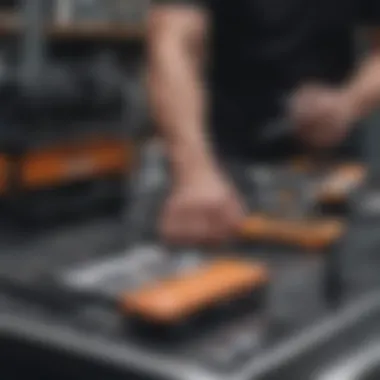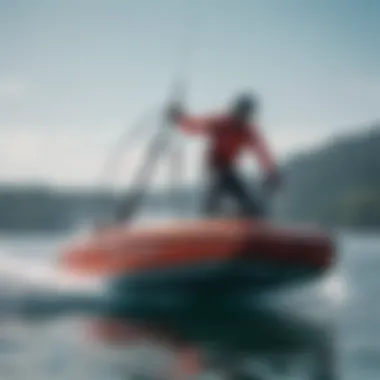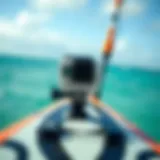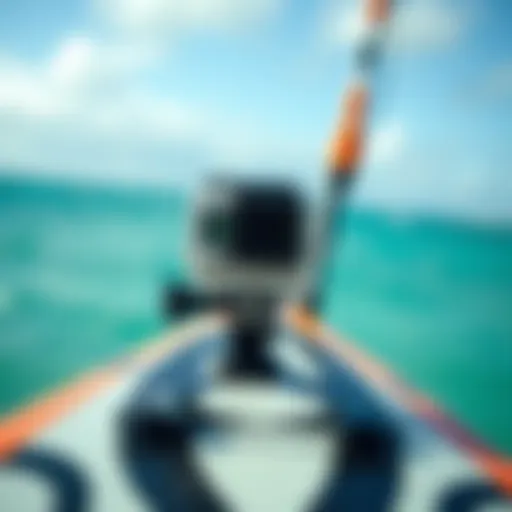Understanding Efoiling Costs: A Detailed Guide


Intro
Navigating the exhilarating realm of efoiling not only involves mastering the art of gliding above water but also understanding the financial landscape tied to this sport. Unlike traditional water sports, where basic gear can be relatively easy on the wallet, efoiling can hit a few financial notes that are often overlooked. It’s essential to shine a light on these costs so enthusiasts can make informed decisions as they gear up for what is surely an adrenaline-packed adventure.
When you dip your toes into efoiling, the first thing that hits you is the investment involved. From the all-important initial purchase price of the efoil, maintenance nuances, accessory costs, and even the hurdles of skill development, there’s a hefty covering to be considered. For anyone thinking about taking the plunge, understanding these expenditures is key. Let’s dive deep into these aspects, providing clarity and insights that will aid both novices and seasoned aficionados alike.
Gear Selection
Choosing the right gear is paramount when taking on efoiling, as it can make or break your experiences on the water.
Types of Efoils
Efoils come in diverse varieties to accommodate different styles and preferences. Here are a few to consider:
- Electric-powered efoils: The most common, offering easy lift with battery-reliant propulsion.
- Manual efoils: Suitable for those seeking more control and an engaged ride, though they require a bit of skill and strength.
- All-rounder efoils: Perfect for those wanting a bit of everything, useful for varying conditions.
When deciding between these types, a consideration of your skill level, local conditions, and riding preferences plays a crucial role. Each variant brings its own set of advantages; picking the one that resonates with you means the difference between an exhilarating ride and a challenging struggle.
Choosing the Right Board
The board is just as significant as the efoil itself. Here are a few points to think about:
- Length and Width: Longer boards offer more stability, making them ideal for beginners. However, those who prefer agility often pick shorter models.
- Material: Durable materials may cost more upfront, but can save money on replacements down the line.
- Weight Capacity: Ensuring your board can handle your weight ensures a smoother, more enjoyable ride.
Selecting a board that matches your body type and riding style significantly impacts both performance and enjoyment. It can be beneficial to reach out to seasoned riders for recommendations or trial runs before making a purchase.
Skill Development
Arming yourself with the right gear is only half the battle. Skill development should not be neglected, as it directly influences your safety and enjoyment on the water.
Essential Techniques
Mastering efoiling demands a diverse skill set, from maintaining balance to effective maneuvering. Here are some critical techniques:
- Finding your balance is crucial to staying atop the efoil. Practice makes perfect.
- Learning how to control the throttle is significant; too much power can lead to crashes, while too little can hinder lift.
- Basic turns and carving can elevate your experience, so spending time mastering these movements pays off.
Progression Tips
Every efoiler starts somewhere. Gradual progression is key:
- Start on calm waters: This allows for practice without the added challenge of waves.
- Take it slow: Begin with short rides to build confidence before committing to longer sessions.
- Replay and learn: Video documentation of your riding can bring awareness to areas of improvement that might not be visible during a ride.
"Training today is saving yourself from trouble later".
Investing in lessons from seasoned efoilers can also facilitate faster growth and development, ultimately leading to more enjoyable experiences on the water.
Understanding the financial, technical, and skill components of efoiling equips you to make a more informed commitment to the sport. Through diligent gear selection, refining essential techniques, and progression, efoiling can transform from a novelty into a deeply satisfying passion.
Prelims to Efoiling
Efoiling is not just another water sport; it's a transformative experience, combining the thrill of surfing with advancements in electric propulsion. This section aims to establish a solid understanding of what efoiling involves, its appeal, and why it's gaining traction among adventurers and water sports enthusiasts alike. By unpacking the essential components of efoiling, we can appreciate the financial considerations that come with this electrifying activity.
Defining Efoiling
Efoiling can be defined as a type of surfing that uses an electric hydrofoil to lift the board above the water, allowing the rider to glide smoothly over the surface. It merges technology with the traditional elements of surfing, providing an almost weightless sensation. This craft consists of a board equipped with a hydrofoil and an electric motor powered by a rechargeable battery.
People new to this sport might find it a tad confusing at first, as it combines aspects of wakeboarding and traditional surfing in a fresh way. Efoilers can ride waves, flat water, or even small swells, making it highly versatile.
The real beauty of efoiling lies in its accessibility. Unlike traditional surfing, where skills and conditions play a significant role, efoiling opens up a new world for even beginners. It invites everyone to enjoy the water, regardless of their riding proficiency or age.
The Rising Popularity of Efoils
In recent years, efoiling has seen a remarkable surge in popularity, especially among watersport enthusiasts who are always on the lookout for the next big thrill.


Several reasons contribute to this upswing:
- Versatility: Efoils are suitable for various water conditions, making them appealing in diverse environments.
- Accessibility: Unlike some other extreme sports, efoiling can be learned relatively quickly, allowing newcomers to participate without extensive training.
- Thrill Factor: The sensation of gliding above water is exhilarating. Riders often describe the experience as liberating. It's like flying over water, a dream for many.
- Technological Innovation: Brands are constantly innovating in this space, releasing models with better performance, longer battery life, and improved safety features.
"Efoiling isn't just a pastime; it's a gateway to a new lifestyle on the water."
Understandably, this increase in efoiling's popularity can also create a spike in demand for equipment and facilities, which leads directly back to the financial considerations that will be explored throughout this analysis. As the efoiling community grows, so too does the need to understand what it entails in terms of costs and commitments.
With this foundation in understanding efoiling, we can now transition into a deeper examination of the initial purchase costs, the factors influencing the price, and what budget-friendly options might exist for those keen to ride the waves.
Initial Purchase Costs
When it comes to diving into efoiling, the initial purchase costs can be a bit of a buzzkill — they definitely pack a punch. Yet, understanding these costs is crucial in making an informed decision. Efoiling offers a blend of thrill and accessibility not found in traditional watersports, but this excitement has its price tag.
Investing in this sport involves more than just splashing out on a board and hoping for the best.
Here, we’ll explore what you need to consider when calculating these costs, as well as some hidden factors that can impact your financial planning.
Understanding Efoil Pricing
Efoils come with a wide range of pricing depending on various aspects. Typically, a decent efoil can range from two to five thousand dollars, but it can go much higher as you look at premium brands and custom options. It’s not just a straightforward number on a price tag. Factors like brand reputation, technological innovations, and even material quality play important roles in determining that final cost.
For example, a brand like Lift Foils, renowned for their advanced technology, tends to sit at the higher end of the market, but many believe the investment is worthwhile due to performance and durability. On the other hand, some newcomers to the market might offer lower prices, enticing cautious buyers.
Factors Influencing Efoil Cost
Several factors come into play when determining the exact price of an efoil.
Brand
The brand you choose has significant weight in your wallet. Established names such as Lift Foils or ESurf have carved out a niche due to their engineered excellence and brand loyalty. While it might be tempting to opt for a lesser-known brand to save some cash, you might be sacrificing crucial aspects like support service and product reliability. Fender like Lift Foils stand out for their robust design and efficient performance, but they come with a heftier price tag, especially in comparison to more budget-friendly options.
Specifications
When it comes to specifications, these will greatly define what you’re paying for. Take into consideration the board size, weight capacity, and materials used. For example, boards made from fiberglass versus more advanced carbon fiber options give you very different experiences both on the water and in your pocket. High-performance specifications, such as a greater battery capacity or more efficient propulsion systems, can drastically increase costs, but they may be worth it for the serious enthusiast. You don’t want a one-trick pony that can only perform under perfect conditions; look for boards that can handle diverse water types.
Technological Features
The technological features integrated into an efoil can differentiate the haves from the have nots. Some boards come equipped with sophisticated systems for monitoring battery life or performance analytics through an app, while others might stick to more rudimentary setups. While these advancements add functionality, they also add to the price. Advanced features, like adjustable ride heights and customizable speed settings, are enticing, but, again, make sure they align with your skill level and intended usage — don't just spend the money because it sounds flashy. Investing in tech can certainly enhance the experience, but consider if you will genuinely utilize those features before parting with your hard-earned cash.
Budget-Friendly Options
Not everyone can drop a fortune on efoils, and thankfully, the market is responding to this need. Several brands are launching more affordable options that maintain decent performance and quality.
- Entry-level Boards: Look for brands that offer entry-level models. These boats might lack some flashy features but will still get you flying on the water.
- Used Market: Consider checking out online marketplaces or community forums, like on Reddit, where individuals often sell their previous models after trying efoiling out.
- Bundling Gear: Keep an eye out for packages that include essentials such as batteries and chargers along with the board. These bundled deals can save you extra bucks in the long run.
With these options, your dream of efoiling may be more feasible than previously thought. Remember, it’s not just about the initial sticker shock; it’s about longevity and finding the best fit for your specific needs.
Additional Gear and Accessories
When considering the costs associated with efoiling, you can't overlook the importance of additional gear and accessories. These items not only enhance the efoiling experience but also play a vital role in safety and equipment longevity. Evaluating these costs is essential for anyone serious about diving into the world of efoiling.
Essential Accessories for Efoiling
Safety Gear
Safety gear is an essential aspect of efoiling that directly impacts the safety of the rider. In the sport, equipment malfunctions or unexpected water conditions can spell trouble if one is not adequately prepared. A good life jacket, specifically one designed for water sports, is a must. This type of flotation device not only provides buoyancy but is also tailored to allow greater freedom of movement, which is crucial when navigating the board.
Beyond life jackets, helmets are becoming increasingly popular among efoilers. Here’s why:
- Head protection: In case of falls, having a helmet can prevent serious injuries.
- Visibility: Some helmets come with reflective materials or colors, enhancing visibility for others.
While safety gear may seem like an extra expense, it’s undeniably a wise investment. The peace of mind that comes from knowing you’re protected is invaluable, especially as the waves get rougher.
Batteries


The efficiency and performance of efoils largely depend on high-quality batteries. These powerhouses are the backbone of any efoiling experience, delivering the energy needed to keep you gliding over the water. A reliable battery allows riders to enjoy longer sessions without the worry of frequent recharges.
Key characteristics to highlight about efoil batteries include:
- Capacity: The larger the capacity, the longer you can ride.
- Weight: Lighter batteries improve maneuverability and performance.
One unique feature of some advanced batteries is their quick-charge capability. This can dramatically reduce downtime between sessions. However, it’s important to note that high capacity and quick-charge features come with a higher price tag. Riders need to weigh their priorities—opt for premium performance or budget-friendly options based on individual needs.
Charging Equipment
Having the right charging equipment is paramount for maintaining the usability of efoils. After a thrilling session on the water, managing power levels effectively is key. The charger that comes with the efoil is not always the only option available. Users can look for faster chargers that allow for more frequent use without lengthy wait times.
- Standard Chargers: These are often included but can take longer to charge fully.
- Fast Chargers: They significantly cut down the time before you’re back on the water, but be aware that they can strain the battery life with continuous use.
Moreover, portable chargers are growing in popularity. They let you charge on-the-go, which is a game-changer for spontaneous trips. However, one must consider their durability and compatibility with different efoil models.
Optional Enhancements
When you’ve got the basics covered, the fun can really begin with optional enhancements. These add-ons aren’t necessary but can take your efoiling experience to exhilarating new heights. From upgraded boards to better fins, these enhancements can significantly improve performance and aesthetic appeal.
- Upgraded boards: Lighter and more aerodynamically designed boards can increase speed and agility.
- Custom fins: Different fin shapes can provide better stability and control.
Opting for these enhancements could lead to a greater investment, but the enhancement of the overall experience is often well worth it.
"Choosing the right accessories and enhancements can turn a good efoiling experience into an unforgettable one."
Making informed decisions about these additional costs can give you a clearer picture of what lies ahead financially in your efoiling journey.
Maintenance Costs
When it comes to enjoying efoiling with peace of mind, maintenance costs play a pivotal role. They are not merely an afterthought but a crucial aspect that potential efoilers should take into account. Regular maintenance ensures not just optimal performance, but also enhances the lifespan of your gear, thereby safeguarding your investment. Riders who neglect this area may find themselves facing hefty repair bills or worse, reduced enjoyment on the water due to equipment failures.
Routine Maintenance Expenses
Routine maintenance expenses can vary based on usage and the specific gear involved, but understanding what they generally entail is essential for any efoiling enthusiast. Frequent checks and upkeep will largely influence your overall spending. Here are some common costs involved:
- Battery Inspection and Maintenance: At the heart of an efoil is its battery. Regular checks to ensure it's in good condition can prevent unexpected failures during rides. This might involve replacing the battery every few years, which can cost anywhere from $500 to $1,200.
- Propeller Care: Keeping the propeller clean and free from damage enhances efficiency. Replacements may be needed based on wear and tear, which could set you back about $100 to $300.
- Foil Maintenance: Regularly inspecting and cleaning the foil is also vital to avoid rust and corrosion. Keeping an eye here can prevent costly repairs, as new foils can cost upwards of $1,000.
Moreover, anyone serious about efoiling should consider investing in performance upgrades such as harnesses and foot pads that can wear over time. These upgrades might not be mandatory but can provide a noticeable difference in comfort and handling.
"Maintenance isn’t just about fixing what’s broken; it’s about preventing problems before they become costly."
Repair and Replacement Considerations
Unfortunately, accidents can happen, and wear can consume even the best equipment. In the world of efoiling, repair and replacement considerations are quite important. Here’s a breakdown of what to account for:
- Dings and Scratches: Even minor damages, particularly to the body of the board or the foil, can lead to larger issues if not addressed. Repairs on these can range from $50 for minor scratches to several hundred for deeper dings that require more extensive work.
- Electronics and Wiring: The electronic components of an efoil are particularly sensitive, and water exposure can lead to failures. Replacing these might be more costly, often between $200 to $500 for decent repairs.
- Upgrading vs. Repairing: When the repair costs approach or exceed a new purchase price, efoilers might be faced with a tough decision—repair or replace? This is especially true as technology in efoiling improves. Investing in a new model can sometimes be more financially sound than pouring money into outdated gear.
In navigating the world of efoiling, understanding maintenance and repair costs can be the difference between a rewarding experience and a frustrating one. By preparing for these expenses, efoilers can enjoy their sport knowing they’ve covered all their bases.
Long-Term Financial Considerations
When thinking about efoiling, it’s easy to get caught up in the initial thrills—new gear, the feel of the wind, and the rush of gliding over the water. However, it’s crucial to pull back and set your sights on the horizon, considering the long-term implications of your investment. This segment delves into various elements of long-term financial considerations that can significantly impact your enjoyment and experience.
Many enthusiasts might overlook the importance of understanding how the cost of efoiling extends beyond just the purchase and immediate expenses. Instead, it’s about framing the full picture, not just the snapshot. Key elements include resale value persistence and insurance costs, both of which have a profound effect on your overall financial landscape in the efoiling world.
Resale Value of Efoils
Efoiling is gaining traction, but like any emerging trend, the understanding of its resale value is still maturing. Efoils, especially models by recognized companies, can hold their value much better than lesser-known brands. Many folks think, "Why bother? It’s just something I enjoy now," but having an eye on the future can help you recover a chunk of your initial investment.
Considerations affecting resale value include:
- Brand Reputation: More established brands often translate into higher resale values. Products from companies like Lift Foils or Fliteboard typically are sought after in the second-hand market.
- Condition: Just like with used cars, how you treat your efoil matters. A well-maintained board with minimal scratches appeals more to buyers.
- Upgrades: If you’ve added or replaced parts that enhance performance, it might give you a boost when selling.


While it might seem like a leap, think of this as a way to mitigate costs over time, which can make efoiling feel more palatable financially.
A well-recognized brand with good upkeep might fetch about 60-75% of its original price even after a couple of years, while off-brand models might barely scrape 30%.
Insurance Costs
Diving into the waters of efoiling also brings the need for proper insurance. Whether it’s protecting your gear against theft or damage, or covering liability in the unpredictable world of watersports, contemplating insurance costs can save you a headache later.
Key factors to think about include:
- Type of Coverage: Liability coverage can be crucial if you’re participating in events or crowded waters. If something goes awry, you'll find peace of mind in knowing you’re protected.
- Premiums: Depending on your location, premiums can vary widely. Coastal areas might have higher rates given the risks involved.
- Policy Limits: Ensure your insurance reflects the full value of your gear and potential liabilities. It would be wise not to undervalue your assets here.
Incorporating a thorough understanding of insurance into your long-term financial planning around efoiling means you can ride the waves with confidence, avoiding nasty surprises.
Holding these aspects of long-term financial considerations in mind can transform your approach to efoiling, allowing for a well-rounded and far-sighted strategy that enhances your experience and mitigates potential pitfalls.
Comparing Efoiling with Traditional Watersports
When diving into the world of efoiling, it's essential to put it side by side with traditional watersports to truly grasp its financial implications. For many enthusiasts, understanding these comparisons will help in making informed decisions about their investment. Efoiling presents a modern twist on familiar watersport activities such as surfing, kayaking, or wakeboarding. However, the costs associated with efoiling can feel daunting without a frame of reference. Based on different aspects, an analysis in this domain emphasizes both the costs and benefits that come with this electric-infused aquatic experience.
One key factor in comparison is initial setups. Traditional watersports often require a single purchase—like a surfboard or kayak—while efoiling involves multiple components including the board, motor, and battery. This segmentation may elevate the entry cost for those new to the sport. Additionally, insights into the ongoing expenses surrounding equipment maintenance, insurance, and accessory needs will showcase how it fits into an individual’s lifestyle.
Cost Comparisons
To break down the numbers, efoiling can be significantly pricier than most traditional options. However, let's explore how these numbers stack up:
- Initial investment: The average cost for an efoil ranges broadly, normally between $3,000 and $12,000. In contrast, a good-quality kiteboard might start at around $1,000.
- Long-term expenses: Owning an efoil often means additional costs, like battery replacements every few years, each ranging in cost from $500 to $1,200. On the other hand, traditional boards may not require such an expensive upkeep unless damaged.
- Maintenance: Efoils necessitate more attention. Users might spend hundreds yearly on general maintenance unless opting for self-repair, which needs a level of technical know-how not typically required in traditional sports.
Moreover, where an average surf session can be enjoyed in various public spaces, efoiling may face local regulations and permits, bringing additional costs into play that traditional sports might not see. Thus, potential efoilers ought to keep these elements at the forefront as they weigh the advantages of each sport.
Value Proposition
The ultimate question remains: is efoiling worth it? Understanding the value proposition can greatly help in making this determination. Here are multiple benefits of efoiling that might justify its costs:
- Accessibility: Unlike traditional kiteboarding or surfing, efoiling allows riders to experience the fun without the need for waves or wind, letting enthusiasts ride on flat water. It's a radical shift in experience that offers a unique thrill.
- Time Efficiency: For many who live far from the coast or popular water spots, transporting compact efoil equipment can also save time in the long run, negating lengthy travel setups involved with traditional larger gear.
- Community Growth: Efoiling has fostered an emergent community of enthusiasts and innovators seeking to push the boundaries. By joining this community, one can connect, share advice, and take part in events, enhancing the overall experience.
In summation, while the upfront costs of efoiling can be higher, the enjoyment derived from its flexibility, efficiency, and community may well compensate for the financial outlay. Both current and prospective riders should carefully assess how much they value these factors in their watersport pursuits to determine if efoiling presents a worthy adventure.
Environmental and Social Implications
The emergence of efoiling, a thrilling combination of aquatic exhilaration and cutting-edge technology, necessitates a deeper exploration of its environmental and social implications. As the popularity of this sport continues to rise, it becomes essential to scrutinize the ecological footprint it leaves behind, alongside its broader effects on communities and waterways.
One of the primary reasons to consider the environmental impact of efoiling is the inherent nature of the sport itself. The reliance on batteries and electric motors can raise flags about pollution and resource use, particularly in sensitive marine ecosystems. This analysis is crucial for enthusiasts keen on minimizing their impact while indulging in their passion. Moreover, responsible efoiling practices can support the sustainable growth of the sport, ensuring future generations can enjoy similar opportunities without sacrificing environmental integrity.
Several key elements come into play when discussing the environmental and social implications of efoiling:
- Ecosystem Disruption: The establishment of efoiling communities may inadvertently disrupt local wildlife and ecosystems, affecting breeding and feeding grounds.
- Energy Sources: The source of energy powering efoils matters. Renewable energy options like solar or wind can mitigate negative impacts, while reliance on fossil fuels can exacerbate the issue.
- Waterway Access: Increased access to waterways for efoiling can sometimes lead to overcrowding, altering the natural beauty of these spaces and potentially leading to conflicts between different user groups, such as traditional boaters and local wildlife.
Moreover, these implications are not just limited to the natural environment but extend to social considerations as well.
Finale
In wrapping up our extensive exploration of efoiling costs, it’s crucial to emphasize the layered importance this topic holds for both novices and seasoned enthusiasts. The financial landscape surrounding efoiling is unlike any other sport, shaped by a variety of elements ranging from initial investments to ongoing maintenance and potential resale. A well-rounded understanding of these costs not only aids in personal budgeting but also fosters informed decision-making regarding efoiling.
Summarizing the Cost Breakdown
To distill the information discussed, here’s a concise breakdown of the unique costs involved in efoiling:
- Initial Purchase Costs: The price of purchasing an efoil is the most significant upfront expense. Quality brands like Lift Foils and Fliteboard command higher prices, often exceeding several thousand dollars, while budget alternatives can be more accessible but might compromise on features or durability.
- Additional Gear and Accessories: Safety gear is not an afterthought. By investing in quality equipment like life jackets and helmets, you not only adhere to safety standards but also ensure your time on the water is as thrilling as it is secure.
- Ongoing Maintenance Costs: Regular maintenance, including battery care and foil check-ups, is essential to prolong the life of your efoil. This part of the expenditure might quietly accumulate over time but is crucial for your efoiling experience.
Understanding these costs is vital for anyone looking to dive into this sport. It gives a realistic picture, helping to manage expectations and budget accordingly.
Future Trends and Expectations
Peering into the future of efoiling, one can expect several trends to emerge. The rise of innovative technologies, like increasingly efficient batteries and lighter materials, may drive down costs while enhancing performance and accessibility. Communities and social groups dedicated to efoiling are likely to expand, cultivating environments where enthusiasts can share resources and tips.
In terms of sustainability, manufacturers are beginning to recognize the environmental impact and are working on eco-friendly advancements. The idea of electric sports evolving into something more sustainable may soon be more than just a pipe dream.
Finally, social acceptance of efoiling as a mainstream sport could bolster demand, motivating greater investment in equipment and leading to economies of scale. As this thrilling activity becomes more integrated into the global watersports culture, efoiling's cost dynamic might shift significantly, making it more accessible for a broader audience.
This comprehensive analysis underlines that diving into efoiling is not just about the financial outlay; it’s about understanding what you’re investing in—your thrill, your safety, and your connection to a burgeoning community around a sport that perfectly melds technology and adventure.















